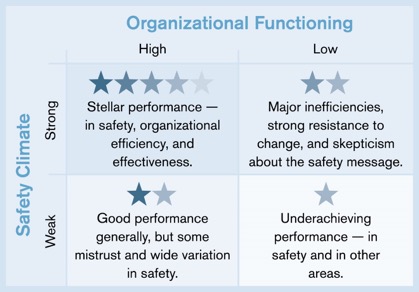May 23, 2018
Building a Strong Safety Culture
We all know that building a strong safety culture is important for the overall success of your organization’s safety effort, but how does this connection actually work? Is it a general idea you take on faith? Or, is it something that can be demonstrated?
In the book we co-authored, 7 Insights Into Safety Leadership, we present a set of cultural characteristics are essential for improving safety and support organizational performance in general. A culture assessment focused on these attributes can predict safety engagement of front-line employees, injury frequency, and a set of performance variables that apply outside safety as well.
These characteristics of organizational culture break down into two broad categories. One category is called “safety climate” or sometimes “safety culture.” It is specific to safety and asks, “In this organization, do we value safety? Do managers, supervisors, and workers demonstrate that worker safety is important to them?”.
The other category has to do with organizational functioning. It describes the kinds of relationships that help people do their best work. Research shows that trusting, reciprocal relationships between people at every level create a positive working environment and high organizational functioning. High organizational functioning, in turn, leads to better engagement, more teamwork, and stronger loyalty. People invest discretionary time and effort. They are enthusiastic about their work.
This idea of social reciprocity is an important one for organizations. An employee who is part of a culture endowed with both of these characteristics has the sense that, “This organization and the people in it care about me.” And the more people feel that, the more they reciprocate by doing really fine work, going the extra mile, being committed, being engaged with the work, and all those other good things.
On the other hand, when organizational functioning is low, trust and communication are compromised. People feel insecure, or even threatened, and they respond by protecting their own interests. If I think, “This is an organization that doesn’t care about me, that doesn’t support me, that isn’t really on my side,” then my next thought is, “Tell me what time I’m supposed to leave and I’m leaving. Tell me the minimum I have to do to get by, and that’s what I’ll be doing.” And why wouldn’t I?

Organizational functioning and safety culture interact with each other in ways that affect decisions, safety-related behavior, and performance. As summarized in the above figure, high organizational functioning stokes the motivation to perform, while a positive safety culture focuses people on what’s important. And of course, the inverse is also true: Low organizational functioning drains motivation, and a weak safety climate scatters focus.
When organizational functioning is high and the safety climate is strong, people step up and contribute to safety in really effective ways. Team leads don’t just grab a generic pre-job safety briefing off the internet five minutes before they need it and read it to their team in a monotone voice; no, they invest the time and creativity to prepare an informative briefing on a relevant topic and practice until they can communicate it effectively. This same commitment to excellence is seen in other areas that are clearly valued by the organization. The high levels of trust make change implementations more efficient, and the strong communication and teamwork yield higher levels of organizational effectiveness.
Learn more about safety culture in our book 7 Insights Into Safety Leadership, or if you are interested organizational culture, read Tom Krause‘s newest book If Your Culture Could Talk: A Story About Culture Change.


